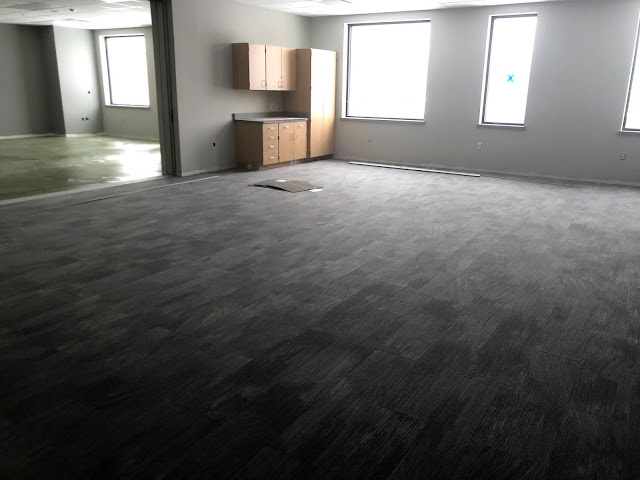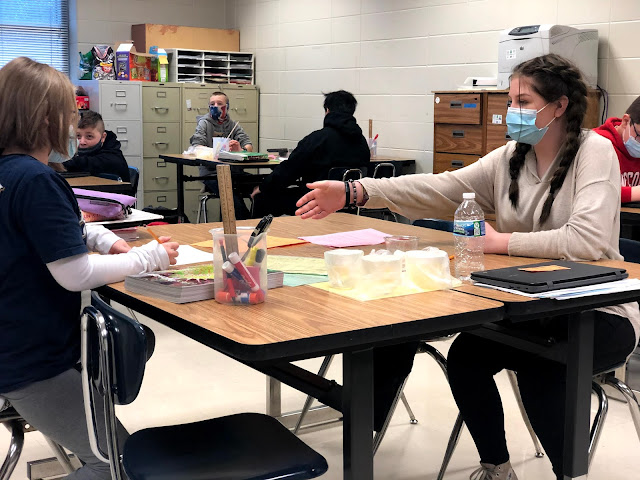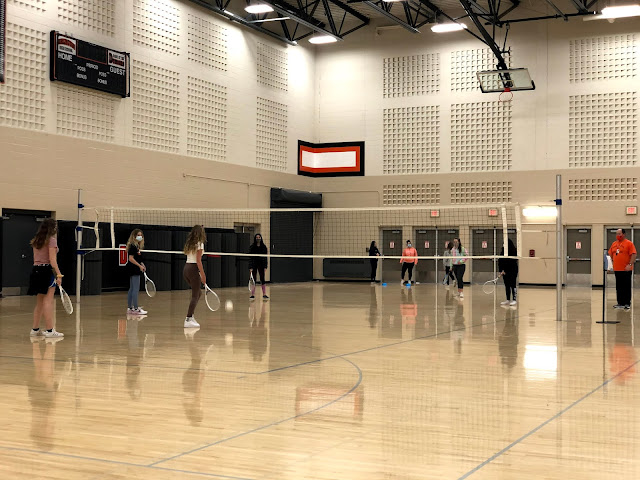- Thank you all for your flexibility and assistance with the start of semester 2 as we had changes to student schedules, the addition of new students, and the addition of the virtual sections - which we are calling Burlington Connected. We really appreciate everyone helping notice little tweaks or adjustments that are needed and communicating those with either Steve, Annie, or myself.
- Kudos to Hans Block for his willingness to each grades 3-4 first semester and the first week of semester 2! Starting January 11 he is with Karcher students and staff full time!
- Therefore, those who had a duty to assist in PE can now remain in your ALL sections.
- Thank you to Stephanie Rummler (reg ed), Jon Nelson (elective), Melissa Miskell (SPED), & Michele Pulera (support staff) who are all part of our 6-8 team for their willingness to participate in the Payne & Frazier equity training we are engaging in as a school district! This is an additional training outside of the National Equity Project. We have had another team engaging with Payne & Frazier already, this will be the second group of staff members participating with them! The training consists of five 3 hour trainings starting in January and running through May. Thank you to those listed above for their willingness to participate and be a Goose!
- Please welcome Alexis Dahlberg, new student teacher who joined out team this past Wednesday! She will be student teaching with Stephanie Rummler and will be with us for the duration of the semester! She comes to us from Concordia University and is very excited to be working with Stephanie and our team! So... if you see a person following Stephanie around... it probably is Alexis!
- Welcome Alexis!
Acceleration, not remediation: Lessons from the field
David Steiner / Simaran Bakshi
6.26.2020
David Steiner:
Across the country, preparation is underway for the new school year, with clearly justified concerns over such matters as transport to school, temperature checks and social distancing, the mental and emotional wellbeing of students and teachers, and the possibility of having to combine face-to-face with online learning in a variety of different models.
In the midst of so many challenges, school leaders are also dealing with the almost certain fact that students will have learned and retained considerably less in their 2019–2020 school year than is normally the case. NWEA has attempted to quantify the combination of the usual “summer melt” (what students ordinarily forget over the summer holiday) with the fact that they will have learned much less from online teaching or working with reading packets than had they attended school: “In mathematics, students are likely to show much smaller learning gains, returning with less than 50 percent of the learning gains and in some grades”.
These learning losses are not only large, but are distributed differently across socioeconomic groups. We know that low-income students have had far less access to internet accessibility and the hardware required to access on-line instruction, and are thus likely to have been even harder hit during the Covid-19 crisis. Since such students were far more likely to be academically behind their more privileged peers before Covid-19, they will, in comparative terms, be even further below grade level when they return to school.
In these circumstances, schools may be tempted to focus on the need to” remediate” their students—indeed, to do so more than ever before. Remediation in the United States has traditionally meant that teachers try to provide students whose work is deemed “below grade level” with the material that they had not learned the first time around. Often this is called “meeting students where they are.”
This well-intentioned strategy sounds like common sense. But as I have suggested elsewhere, there is strong evidence that this approach just doesn’t work. It is deeply discouraging to students, and in most cases, simply locks them into a permanent and debilitating learning gap. Instead, in that article, my co-author Daniel Weisberg and I advocate for accelerating rather than remediating.
But what does acceleration look like in practice? One way to answer this is to look at schools that effectively accelerate their students’ learning, every day, every year. Wayman Academy of the Arts in Jacksonville, Florida, is such a place. And what follows is a first-hand account from its principal, Simaran Bakshi, one of Florida’s TaxWatch Principal Leadership Award winners for 2020, who explains how the school does this.
Simaran Bakshi:
When I became principal of Wayman Academy in 2013, it was a low-performing charter school in the poorest neighborhood of Jacksonville, surrounded by other low-performing schools. More than 90 percent of the students performed one or two years below grade level. Few parents were involved in school life. There was a chronic teacher shortage because of the neighborhood’s reputation and the school’s lack of retirement benefits. My charges were simply to keep the school open and not receive another “F” on Florida’s school rating calculation, which is a combination of students’ academic proficiency and growth.
Fast forward to three years later, and the school’s grade had improved to a “B.” Then, in each of the following four years, from 2015 to 2019, Wayman outperformed every school in the district with similar demographics and earned a “high-performing status” from the Florida State Department of Education in 2019, and is now an “A” school.
How did it happen?
My motto has always been “keep it simple,” in both my personal and professional life. In the world of K–12 education, we love to make things complex—and low performance almost inevitably results. Complexity allows teachers and school leaders to claim that they are “doing more,” while the lines of real responsibility in fact become hopelessly blurred, and the overarching “system” becomes the scapegoat for the results. Overcomplicating things especially overwhelms those teachers and students who are already struggling.
So as the principal at Wayman, I have been combatting complexity in three ways. First, I focus relentlessly on clear, effective instruction. We provide teachers with the right kind of knowledge, tools, and professional development that lead to teaching practices that work. We emphasize mastery of simple, familiar practices that research has found to have the most significant impact on achievement. And professional development is not just couple of sit-down sessions. Teachers train one another, exchange skill-sets, and receive constant feedback from our Leadership Team. This helps us create a culture of high expectations for students and teachers alike.
Second, we accelerate rather than remediate. Teachers do not water down curricula for our struggling students. Instead, we focus on expediting their growth and filling in any gaps in knowledge or skills, all while teaching them grade-appropriate content on a daily basis.
One of the ways we fill these gaps is with Response to Intervention (RTI) time, which occurs outside of the regular school day, every morning. Every staff member in the school is assigned to teach a common skill or standard, under teachers’ supervision, to a group of students who are struggling in that area. Students join different RTI groups as necessary throughout the year based on their progress and needs. This helps us to stay focused on grade-level content during school hours and move everyone forward on the same learning timelines.
Third, we limit assessments to those that give us useful information about our students’ strengths and weaknesses. The assessments are carefully planned at the beginning of the school year, and instructional time is not compromised. For us, this means administering three formative computerized tests each year that monitor student learning and allow our teachers to better tailor their instruction; four growth-monitoring assessments each year to measure how much progress students have made in set amounts of time; and weekly exams to determine how close our pupils are to grade level.
Here’s how this works in two true-to-life classrooms at Wayman Academy, one each in math and English language arts.
Ms. Smith, fifth-grade math: Her first lesson to her class of twenty-two students was on adding unlike fractions. Our diagnostic assessment data showed that twelve of the children were at a third-grade level on that skill—two years behind. Ms. Smith started the lesson by teaching the fifth-grade concept to the whole class. She then had the class work on fully planned, differentiated independent work that was tailored to each students’ mastery of the prerequisite skills—skills meant to be taught in lower grades—that they’d need to understand the new concept. Struggling students had various gaps: some struggled with halves, for example, and some with breaking fractions into smaller units.
Ms. Smith did not go back to teaching third-grade work for multiple days, as it would have left the entire class behind. Instead, for each day’s fifth-grade-level lesson, she focused on filling the gaps that prevented students from grasping it. And then she used RTI hours for those who needed more help. Differentiation in her classroom, however, was relevant to what was being taught that day, so that students could follow along and soon catch up with their on-grade-level peers. The objective of the lesson was applicable to all students. She did not focus on filling the years’ worth of gaps at a slow speed by moving backwards. She pulled the students up to grade-level faster by keeping the focus only on fractions. The resulting data showed that the whole class mastered unlike fractions within the specified time.
This is a daily scenario in Ms. Smith’s class, and the data support her method of teaching. This teacher’s students have outperformed those in the best schools in the district—not just in growth, but also in proficiency, for last four years. There are several Ms. Smiths in our school.
Ms. Jones, fourth-grade English language arts: She introduced her class to a lesson on drawing inferences from a text, and the diagnostic results had shown multiple students one or two grade levels behind on that skill.
She introduced the fourth-grade standard, and then broke the students up for independent work or group activities. Her students were required to read a text, note specific details, and then synthesize them to achieve new understanding. The work was differentiated for various ability groups, but crucially, every child read the same text. The guided groups that Ms. Jones met with were based on the prerequisites required to understand what it meant to infer something. Ms. Jones helped her students slow down and list the important, relevant details on graphic organizers. Then they relied on their background knowledge to make connections, generate predictions, and draw conclusions. Reviewing those “mini-inferences” led to deeper understanding of the text. Finally, that understanding was brought to bear in whole-group discussion.
Since reading requires a broad range of foundational skills, it would have been easy for her to wander into teaching other skill sets instead of staying focused on one. If a student struggled with sounding out a word, for instance, she did not slip into teaching phonics, but rather stayed focused on the progression skills needed for inferencing. The students connected better throughout the lesson, as Ms. Jones kept them within the range of current grade-level skills.
Dealing with students’ wide range of background knowledge and skills when teaching them a new on-grade-level concept is different than simply teaching below-grade-level material. Teachers needs cadence, a rhythm all students can learn in. Explicit planning is the key to help students with learning gaps. It can be done.
At Wayman, i-Ready data over the last four years show consistent progress. At the beginning of the academic year, is not uncommon for only 15 percent of students to be proficient in reading and 20 percent in math. Yet by the end of the year, a full 65 percent or more attain proficiency in reading, and 70 percent do so in math. Tier 3 students, who require the most intensive help to get up to grade level, have a success rate of 95–98 percent of moving up by one grade level or more by the end of the school year.
A school’s performance is directly tied to what we teach and how well we teach it. When we keep it simple by focusing relentlessly on high-level instruction, good things happen. Students accelerate, teachers thrive, and schools shine.
***What we are doing is the RIGHT work! Continue being relentless about what is Essential, hone in on our student data during iTime, and continue using best instructional practices to the best of your abilities given the pandemic (GRR Model). Our BIG THREE are our BIG THREE for a reason! Just keep swimming!!!
- Furniture Selections for Academic Teachers:
- There are 19 teachers who have been asked to select the furniture pieces that will be in the 19 Academic Spaces throughout the building. These, currently, are considered the ELA, Math, Social Studies, and Spanish classrooms.
- Here is the link to the items for them to select.
- Within the link is the teacher desk option that all staff will have - it comes with three pieces. The two desk pieces are at BHS - the desk is in Stacey Stoughton's classroom and the adjustable lecture will travel with the TV/iPad/Apple Pen that will be traveling around to each room.
- Burlington Connected
- Our virtual sections that we are piloting as a different virtual option than JEDI will begin on January 25. This would be the normal start date for semester 2 for all of our JEDI students.
- Those teaching the Burlington Connected sections should currently have no students listed in the designated slot for your virtual section (either an A or B day section).
- HERE is the schedule & information shared with families for Burlington Connected.
- HERE is what our staff are using to organize things for the start so that all of their emails, Google Classroom Links, etc are all in one place for students who are participating.
- Monday, January 11 - District Essential Skills Grading Practices Committee Meeting from 3:45-5:15 via Zoom.
- Recess Reminders:
- Please remind and assist students with remembering that if they want to go outside they need to be dressed appropriately to do so... snow pants, boots, etc in order to play in the snow!
- Wednesday, January 13 - Academic Teachers
- Please use some of your time between 10:30-12:00 to finalize your iTime rotations using our iReady data.
- 2021-2022 K-5 Teams
- Just so you are all aware, all of our K-5 colleagues have been told where they will be teaching for this coming fall. They have also been asked to determine which partner (within 2 section schools) will be teaching ELA and which one will be focusing on Math. As a district we feel it is important to have a bit more of a focus area for all teachers to spend time understanding, especially at the elementary level where they are currently being asked to know all standards for all subject areas. Just an FYI...
- Thursday, January 28 - Parent/Teacher Conferences from 3:30-5:30
- Teams have shared their desired date for conferences. Some shared that there is potential of a volleyball gam on February 11 that would eliminate at least 3 staff members from being able to attend conferences.
- We also had some teams request conferences sooner rather than later.
- Therefore, we will go with the first option, January 28. We will be meeting with BLT this Wednesday and will discuss the format for these conferences!
- Friday, February 12 - 8:00-4:00 Inservice Day
- ALL staff (certified & non-certified) are asked to be in attendance from 8:00-11:30. Non-certified staff, you have hours for the 12th on your return to work notices but they were subject to change. Therefore, wanting you to know the hours shifted a bit!
- Certified staff your work day is 8:00-4:00!
- More details as to what will be taking place when will come in the upcoming weeks!
Picture from this past week!
















